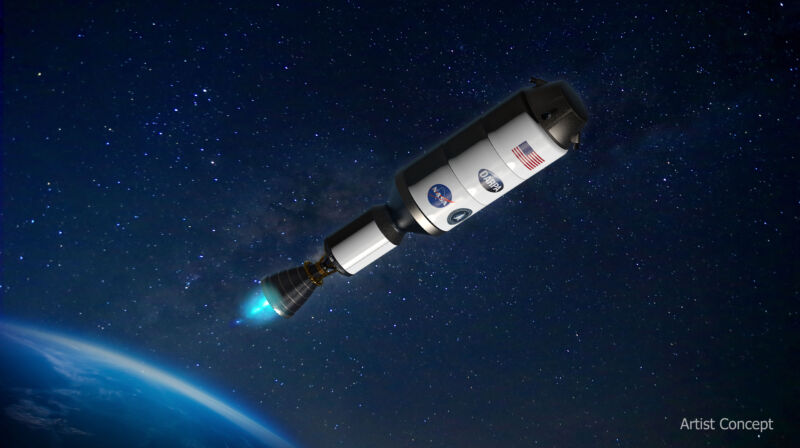
Four years from now, if all goes well, a nuclear-powered rocket engine will launch into space for the first time. The rocket itself will be conventional, but the payload boosted into orbit will be a different matter.
NASA announced Wednesday that it is partnering with the US Department of Defense to launch a nuclear-powered rocket engine into space as early as 2027. The US space agency will invest about $300 million in the project to develop a next-generation propulsion system for in-space transportation.
"NASA is looking to go to Mars with this system," said Anthony Calomino, an engineer at NASA who is leading the agency's space nuclear propulsion technology program. "And this test is really going to give us that foundation."
Back to the future
Traditional chemical propulsion is great for blasting rockets off the surface of the Earth, but such machines are terribly inefficient for moving around the Solar System. They don't sip fuel; they guzzle it. To go as far as Mars would require a huge amount of propellant and liquid oxidizer and take at least six months. For humans to truly become a spacefaring species, there needs to be a better way.
Wernher von Braun, the German engineer who defected to the United States after World War II, recognized the potential of nuclear thermal propulsion even before his Saturn V rocket landed humans on the Moon with chemical propulsion. Eventually, this led to a project called NERVA (Nuclear Engine for Rocket Vehicle Application). It was eventually canceled to help pay for the Space Shuttle.
The basic idea is straightforward: A nuclear reactor rapidly heats up a propellant, probably liquid hydrogen, and then this gas expands and is passed out a nozzle, creating thrust. But engineering all of this for in-space propulsion is challenging, and then there is the regulatory difficulty of building a nuclear reactor and safely launching it into space.
And so nuclear thermal propulsion technology sat on the shelf for a long, long time. Finally, in 2020, the curious folks at the US Defense Advanced Research Projects Agency said they wanted to test a flyable nuclear thermal propulsion system. This planted the seed for a program called the Demonstration Rocket for Agile Cislunar Operations (DRACO). The military was interested in efficiently moving payloads around Earth and the Moon—hence the inclusion of cislunar.
NASA later joined in, with the goal of developing similar technology for a Mars mission. The reason is obvious: A lot of scientists and engineers believe that the only sustainable way to develop a Mars exploration program is through the use of nuclear propulsion.
The plan forward
On Wednesday, NASA and DARPA announced they had selected Lockheed Martin to serve as the primary contractor to assemble the experimental nuclear thermal reactor vehicle (X-NTRV) and its engine. BWX Technologies will be one of Lockheed Martin’s partners, and it will develop the nuclear reactor and fabricate the high-assay low-enriched uranium fuel to power the reactor.
The value of the award is $499 million, said Tabitha Dodson, program manager for the effort at DARPA, in a teleconference with reporters.
NASA will take the lead on developing the nuclear engine, and DARPA will oversee a host of other issues, from the nuclear regulatory requirements to the mission's operations and all analyses of the vehicle's safety. The nuclear reactor will launch in "cold" mode for safety reasons and will not be turned on until it reaches a sufficiently high orbit.
This final orbit has yet to be determined, but it is likely to be 700 to 2,000 km above the surface of the Earth, such that the vehicle's reentry into the planet's atmosphere will take place hundreds of years after any nuclear reactions occur.
The nuclear-powered vehicle will launch within the payload fairing of a Falcon 9 or Vulcan rocket, Dodson said, and look much the same as the upper stage of a conventional rocket. It will consist of a large hydrogen fuel tank, a nuclear reactor, a supporting spacecraft structure, and a nozzle. Once it reaches a safe orbit, the reactor will be turned on. The liquid hydrogen will then be heated from 20 Kelvin—just 20° Celsius above absolute zero—to 2,700 Kelvin in less than a second.
And then? Well, we'll see. There are some unknowns about the performance of a reactor and its uranium fuel in zero gravity.
"It's important to keep in mind that this is a demonstration engine," Dodson said. "And just like any other test of a rocket engine, NASA may need to do a series of follow-on engine development work in order to get closer to their perfect operational engine."
Don’t forget about the hydrogen
This experiment is exciting beyond just the testing of the nuclear engine. While plenty of new technology will go into developing a nuclear reactor that can operate in microgravity, a lot of effort will also go into managing the vehicle's liquid hydrogen propellant.
Until now, liquid hydrogen has only been successfully stored in space for days since it boils above the extremely cold temperature of 20 Kelvin. Dodson said this mission would attempt to store liquid hydrogen in its ultra-cold state for a couple of months, allowing enough time for multiple tests of the nuclear thermal engine.
After the propellant runs out, the engine will no longer be able to operate, even though mission controllers on the ground will still retain communication with the spacecraft. The mission could be extended if it could be robotically refueled, and Dodson said the spacecraft designers are attempting to allow for this possibility.
Perhaps NASA and DARPA will have learned enough by then, however, to move into the development of an operational engine that will fly somewhere.
reader comments
388